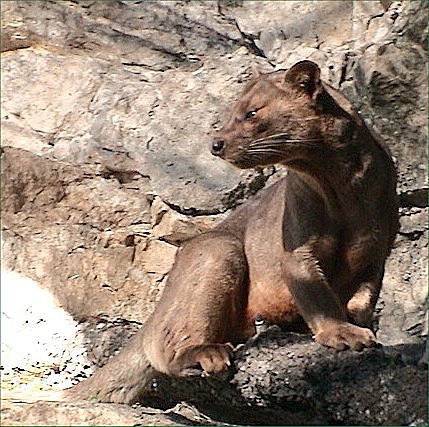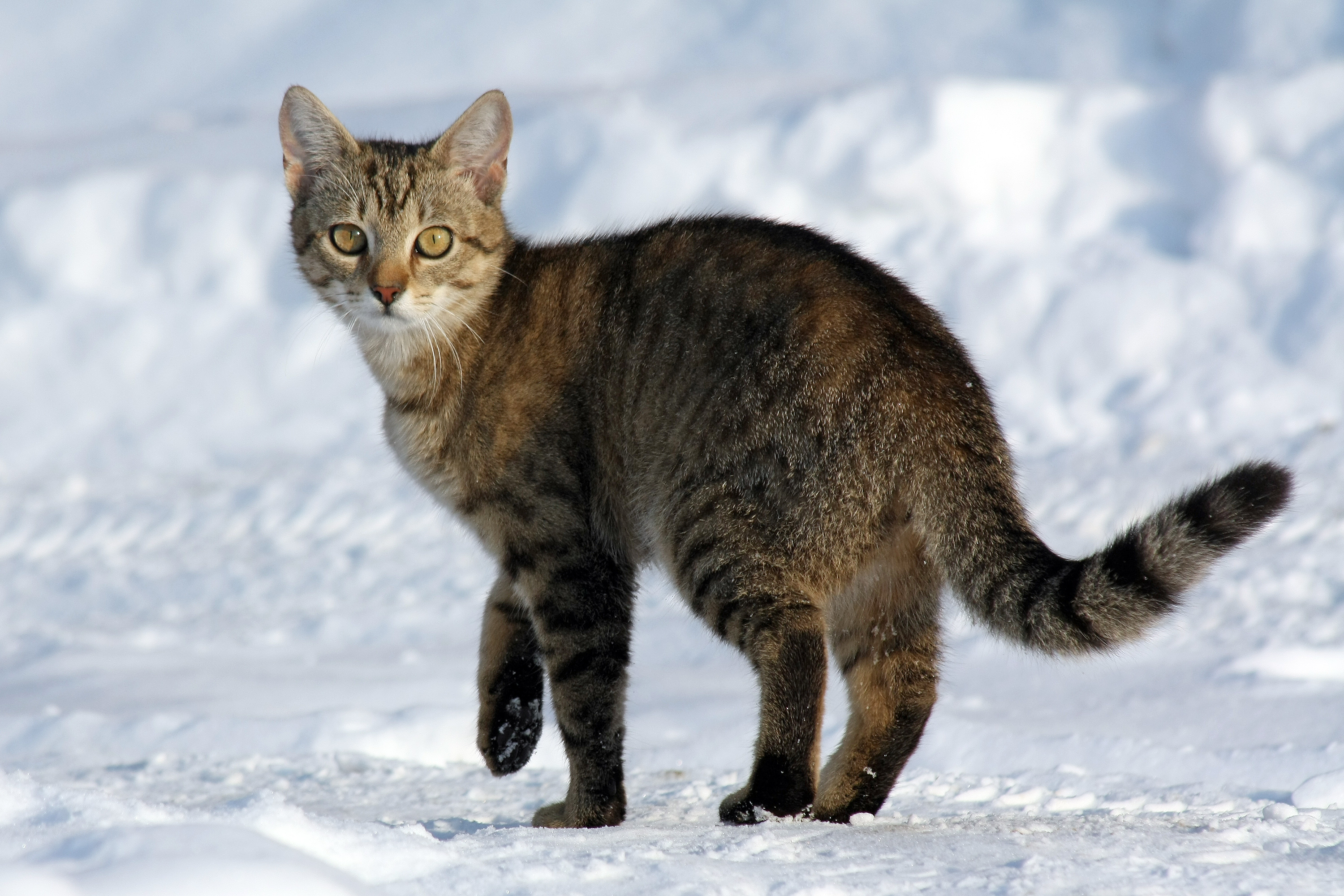|
Nimravidae
Nimravidae is an extinct family (biology), family of carnivorans, sometimes known as false saber-toothed cats, whose fossils are found in North America and Eurasia. Not considered to belong to the true cats (family Felidae), the nimravids are generally considered closely related and classified as a distinct family in the suborder Feliformia. Fossils have been dated from the Middle Eocene through the Late Oligocene epochs (Bartonian through Chattian stages, 41.03–25.9 million years ago), spanning about . The barbourofelids, which were formerly classified as a subfamily of the Nimravidae, were reassigned to their own distinct family Barbourofelidae in 2004. However in the 2020s, some studies suggest the barbourofelids are a branch of the nimravids, suggesting that this debate might not be settled yet. If accepted, the family would have persisted until the Late Miocene, and would extend their spatial distribution to Africa. Taxonomy The family Nimravidae was named by American pale ... [...More Info...] [...Related Items...] OR: [Wikipedia] [Google] [Baidu] |
Barbourofelidae
Barbourofelidae (or Barbourofelinae) is an extinct family (biology), family (or subfamily) of carnivorans of the suborder Feliformia, sometimes known as false saber-toothed cats, that lived in North America, Eurasia and Africa during the Miocene epoch (22.8—7 million years ago) and existed for about . Thought to be an independent lineage from the Nimravidae and Machairodontinae, which had all attained elongated canines, recent research argues that it may be a subfamily of the Nimravidae. Over the recent years, this hypothesis has been gaining more support among experts. Taxonomy The type genus, ''Barbourofelis'', was originally described by Schultz et al. (1970) and assigned to a new tribe, Barbourofelini, within the felid subfamily Machairodontinae, along with the other sabre-toothed cats. Subsequently, the tribe was reassigned to the Nimravidae by Tedford (1978) and raised to a subfamily by Bryant (1991). However, a number of studies in the early 2000s identified a closer aff ... [...More Info...] [...Related Items...] OR: [Wikipedia] [Google] [Baidu] |
Nimravinae
The Nimravinae are a subfamily of the Nimravidae, an extinct family of feliform mammalian carnivores sometimes known as false saber-toothed cats. They were found in North America, Europe, and Asia from the Middle Eocene through the Late Oligocene epochs (Bartonian through Chattian stages, 40.4—23.03 mya), spanning about . Centered in North America, the radiation of the Nimravinae from the Eocene to Oligocene The Oligocene ( ) is a geologic epoch (geology), epoch of the Paleogene Geologic time scale, Period that extends from about 33.9 million to 23 million years before the present ( to ). As with other older geologic periods, the rock beds that defin ... was the first radiation of cat-like carnivorans. References {{Taxonbar, from=Q11884539 Nimravidae Bartonian first appearances Tortonian extinctions Taxa named by Edward Drinker Cope ... [...More Info...] [...Related Items...] OR: [Wikipedia] [Google] [Baidu] |
Hoplophoneus
''Hoplophoneus'' (Greek: "murder" (phonos), "weapon" (hoplo)) is an extinct genus of the family Nimravidae, lived in North America and Asia during the Late Eocene to Early Oligocene epochs from 35.7 to 30.5 mya, existing for approximately . Taxonomy ''H. strigidens'' was considered nomen dubium by Bryant in 1996. In 2000, an unnamed species of ''Hoplophoneus'' within Late Eocene rocks was found in Thailand. In 2016, all North American species of '' Eusmilus'' were placed in ''Hoplophoneus'' by Paul Z. Barrett. However, in 2021, Barret revised this phylogeny. His phylogenetic analysis suggests ''H. cerebralis'', ''H. dakotensis'', and ''H. sicarius'' were actually species of ''Eusmilus'' instead of ''Hoplophoneus''. Description ''Hoplophoneus'', though not a true cat, was similar to cats in outward appearance, though with a robust body and shorter legs. While a 2008 study estimated that the largest individual have weighed , similar to a large jaguar. Other experts suggested a ... [...More Info...] [...Related Items...] OR: [Wikipedia] [Google] [Baidu] |
Eusmilus
''Eusmilus'' ('true sabre') is a prehistoric genus of Nimravidae, nimravid that lived in Europe and North America during the Late Eocene to Early Oligocene epochs (34.7–29.5 Annum, mya). Taxonomy There are three valid species of ''Eusmilus'', ''E. bidentatus'' and ''E. villebramarensis''. ''Ekgmoiteptecela'' MacDonald, 1963 was synonymized with ''Eusmilus'' by some authors, but is actually synonymous with ''Hoplophoneus''. The third species, ''E. adelos'', was described in 2021, and stands as the largest species in the genus. One study performed in 2016 moved all North American species to ''Hoplophoneus''. The discovery of ''E. adelos'' meanwhile, suggests that nimravids went along derived evolutionary pathways; conical-toothed, dirk-toothed, and scimitar-toothed, with and that their evolutionary paths split in two, leading to saber-toothed and conical-tooth forms that convergently evolved with those of true felids tens of millions of years later. Its discovery also sugg ... [...More Info...] [...Related Items...] OR: [Wikipedia] [Google] [Baidu] |
Feliformia
Feliformia is a suborder within the order Carnivora consisting of "cat-like" carnivorans, including Felidae, cats (large and small), hyenas, mongooses, viverrids, and related taxa. Feliformia stands in contrast to the other suborder of Carnivora, Caniformia consisting of "dog-like" carnivorans (includes Canoidea). The separation of the Carnivora into the broad groups of feliforms and caniforms is widely accepted, as is the definition of Feliformia and Caniformia as suborders (sometimes superfamilies). The classification of feliforms as part of the Feliformia suborder or under separate groupings continues to evolve. Systematic classifications dealing with only extant taxa include all feliforms into the Feliformia suborder, though variations exist in the definition and grouping of families and genera.Taxonomic references - extant species (1): Supporting descriptive information and picturesDiversity Web (online) – Feliformia/ref>Taxonomic references - extant species (2)Integrated ... [...More Info...] [...Related Items...] OR: [Wikipedia] [Google] [Baidu] |
Nimravus
''Nimravus'' is an extinct genus of "false" saber-toothed cat that lived in North America and Eurasia during the late Eocene and Oligocene epochs 35.3—27.1 mya, existing for approximately . Not closely related to true saber-toothed cats, they evolved a similar form through parallel evolution. Fossils have been uncovered western U.S. from Oregon to southern California and Nebraska, and Eurasia from France to Mongolia. Description ''Nimravus'' was around in body length. With its sleek body, it may have resembled the modern caracal, although it had a longer back and more dog-like feet with partially retractile claws. It probably hunted birds and small mammals, ambushing them like modern cats, rather than chasing them down. ''Nimravus'' competed with other false sabre-tooths such as ''Hoplophoneus''. Pathology A ''Nimravus'' skull, found in North America, had been pierced in the forehead region, the hole exactly matching the dimensions of the sabre-like canine of ''Eusmil ... [...More Info...] [...Related Items...] OR: [Wikipedia] [Google] [Baidu] |
Nanosmilus
''Nanosmilus'' is a nimravid from the Oligocene ( Whitneyan to Arikareean stages) of Nebraska. As a member of Feliformia, it is related to the superficially similar-appearing true cats. As such, it and nimravid genera in general are often referred to as false saber-toothed cats. No larger than a small bobcat, it is the smallest known saber-toothed mammal currently recognized by science. It is most closely related to its fellow nimravid '' Eusmilus''. Description ''Nanosmilus'' was first discovered in 1880, by Edward Drinker Cope Edward Drinker Cope (July 28, 1840 – April 12, 1897) was an American zoologist, paleontology, paleontologist, comparative anatomy, comparative anatomist, herpetology, herpetologist, and ichthyology, ichthyologist. Born to a wealthy Quaker fam ..., and described from fragmentary material. It wasn't until more complete skulls were discovered that ''Nanosmilus'' became better known to science. For many decades, it was thought to be a member of the ... [...More Info...] [...Related Items...] OR: [Wikipedia] [Google] [Baidu] |
Pangurban
''Pangurban'' is an extinct genus of the family Nimravidae (the false saber-toothed cats), endemic to North America during the Eocene epoch (40–37 mya). It contains a single species, ''Pangurban egiae''. Occurring several million years before other named nimravids in North America, the discovery of this species suggests that hypercarnivores evolved and spread quickly after the warm middle Eocene. Etymology The namesake for the generic name ''Pangurban'' comes from the eponymous white cat in the anonymous 9th century Irish poem Pangur Bán. The species name honors scientist Naoko Egi. Description ''P. egiae'' would have been cat-like in many respects, though since the holotype is incomplete most description would require comparison with close relatives. Using tooth dimensions, the body mass was estimated to be . The species may have been the size of the smallest mountain lions. Due to the close relationship with the better known nimravid Hoplophoneus ''Hoplophoneus'' ( ... [...More Info...] [...Related Items...] OR: [Wikipedia] [Google] [Baidu] |
Felidae
Felidae ( ) is the Family (biology), family of mammals in the Order (biology), order Carnivora colloquially referred to as cats. A member of this family is also called a felid ( ). The 41 extant taxon, extant Felidae species exhibit the greatest diversity in fur patterns of all terrestrial carnivores. Cats have retractile claws, slender muscular bodies and strong flexible forelimbs. Their teeth and facial muscles allow for a powerful bite. They are all obligate carnivores, and most are solitary predators ambushing or stalking their prey. Wild cats occur in Africa, Europe, Asia and the Americas. Some wild cat species are adapted to forest and savanna habitats, some to arid environments, and a few also to wetlands and mountainous terrain. Their activity patterns range from nocturnal and crepuscular to Diurnality, diurnal, depending on their preferred prey species. Reginald Innes Pocock divided the extant Felidae into three subfamilies: the Pantherinae, the Felinae and the Acin ... [...More Info...] [...Related Items...] OR: [Wikipedia] [Google] [Baidu] |
Carnivora
Carnivora ( ) is an order of placental mammals specialized primarily in eating flesh, whose members are formally referred to as carnivorans. The order Carnivora is the sixth largest order of mammals, comprising at least 279 species. Carnivorans are found on every major landmass and in a variety of habitats, ranging from the cold polar regions of Earth to the hyper-arid region of the Sahara Desert and the open seas. Carnivorans exhibit a wide array of body plans, varying greatly in size and shape. Carnivora are divided into two suborders, the Feliformia, containing the true felids and several animals; and the Caniformia, containing the true canids and many animals. The feliforms include the Felidae, Viverridae, hyena, and mongoose families, the majority of which live only in the Old World; cats are the only exception, occurring in the Old World and the New World, entering the Americas via the Bering land bridge. The caniforms include the Caninae, Procyonidae, bears, ... [...More Info...] [...Related Items...] OR: [Wikipedia] [Google] [Baidu] |
Maofelis
''Maofelis cantonensis'' is an extinct basal nimravid from Late Eocene-aged Youganwo Formation of Maoming Basin, Guangdong Province, China China, officially the People's Republic of China (PRC), is a country in East Asia. With population of China, a population exceeding 1.4 billion, it is the list of countries by population (United Nations), second-most populous country after .... References Prehistoric mammals of Asia Nimravidae Eocene carnivorans Fossil taxa described in 2016 Paleontology in Guangdong Monotypic prehistoric carnivoran genera {{paleo-carnivora-stub ... [...More Info...] [...Related Items...] OR: [Wikipedia] [Google] [Baidu] |
Machairodontinae
Machairodontinae (from Ancient Greek μάχαιρα ''Makhaira, machaira,'' a type of Ancient Greek sword and ὀδόντος ''odontos'' meaning tooth) is an extinct subfamily of carnivoran mammals of the cat family Felidae, representing the earliest diverging major branch of the family. Machairodonts varied in size from comparable to lynxes to exceeding that of lions. The Machairodontinae contain many of the extinct predators commonly known as "saber-toothed cats", including those with greatly elongated upper Maxillary canine, maxillary canines, such as the famed genus ''Smilodon'' and ''Megantereon,'' though the degree of elongation was variable, and in some machairodontines like ''Dinofelis'' the length of the upper canines was much more modest. Sometimes, other carnivorous mammals with elongated teeth are also called saber-toothed cats, although they do not belong to the felids. Besides the machairodonts, other saber-toothed predators also arose in the Nimravidae, nimravid ... [...More Info...] [...Related Items...] OR: [Wikipedia] [Google] [Baidu] |





